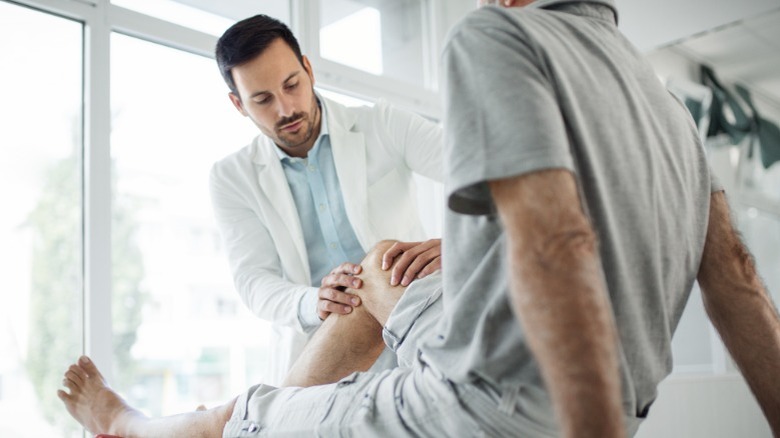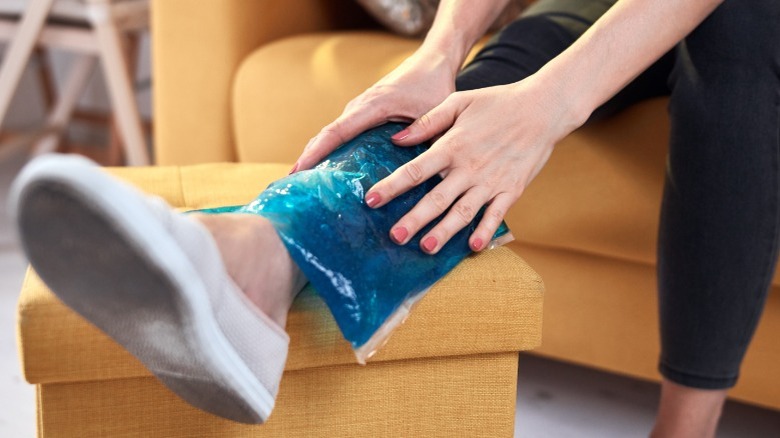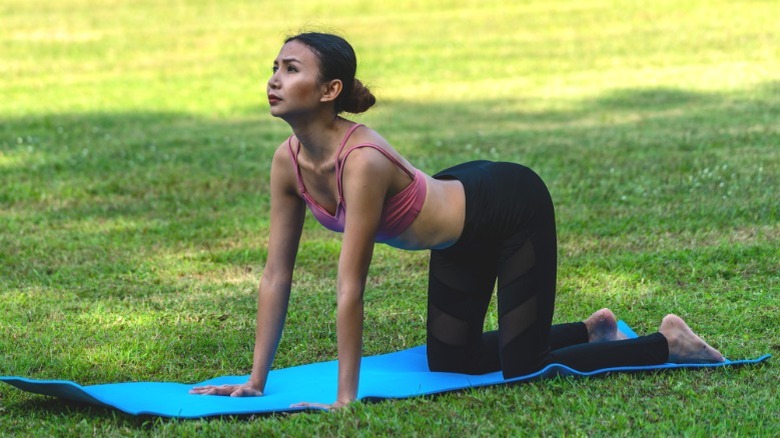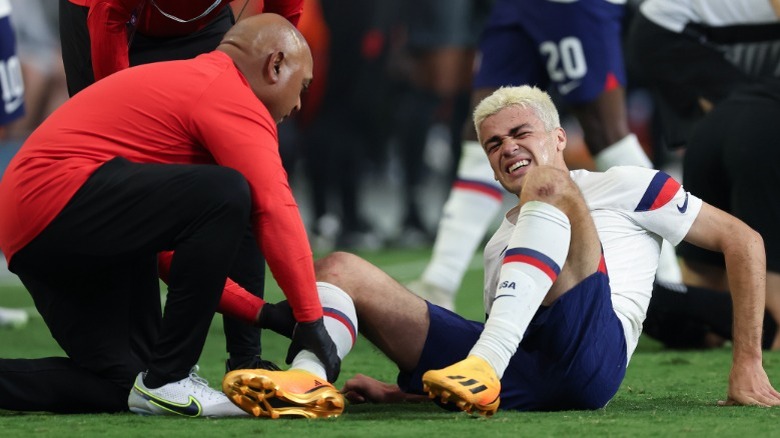What Really Happens To Your Body When You Pull A Muscle?
If you've ever pulled a muscle, you're not alone. A pulled muscle, also known as a muscle strain, is a common injury for many people. Considering that the experts at Better Health Channel remind us that the human body has roughly 600 muscles, it's unsurprising that we end up pulling a muscle every once in a while.
Muscles support so many of our everyday functions. Thus, when you pull a muscle, though it may not be serious, it can impact your quality of life for at least a little while. That's because your muscles support your ability to do basic things like get up from a chair, walk and run. You also rely on muscles to chew and speak. Moreover, your muscles are doing a lot behind the scenes, such as controlling your heartbeat, regulating your body temperature, controlling your breathing and digestive system and helping to regulate your body temperature, according to the experts at Medical News Today.
Though you have muscles throughout your body, pulled muscles tend to occur in certain areas. Here are some insights into the causes of a pulled muscle, the best ways to treat a pulled muscle, and steps you can take to protect yourself from getting them in the first place.
The anatomy of a muscle
To understand the mechanics of what happens when you get a muscle pull, it's helpful to get a basic grasp of the anatomy of your muscle. Muscles are generally divided into three groups: cardiac muscle, smooth muscle, and skeletal muscle, also known as striated muscle (per Encyclopaedia Britannica). Your cardiac muscles are devoted to exactly what you'd expect — your heart. They are involuntary muscles that provide the contractions that pump blood through your body. Smooth muscles — also involuntary muscles — line the walls of blood vessels and organs such as your stomach and urinary bladder.
However, pulled muscles typically occur in your skeletal muscles. The experts at the National Library of Medicine (NLM) explain that your skeletal muscles are voluntary, meaning you operate them by choice. Skeletal muscles support your posture and balance, and are complex soft tissues made of lymphatics, blood vessels, and thousands of fibers that form bundles called fasciculi. Every one of these bundles is immediately surrounded by a sheath called the perimysium, with the outermost connective tissue sheath covering the entire muscle called the epimysium.
Each of your individual skeletal muscle fibers is made up of bundles of cells called myofibrils. Myofilaments within the myofibrils create the muscle's striated appearance. It is this striated pattern that allows your skeletal muscle to contract, leading to the movement of associated bones and allowing you to perform specific tasks and go about your daily activities.
Common areas where you can pull a muscle
Though it's possible to pull a muscle in various places in your body, some of the most common areas where you will experience a pulled muscle are in your lower back, hamstrings, neck, and shoulders. While people who perform active workouts may be more susceptible to pulling a muscle, experts note that simply walking can also cause a pulled muscle.
Pulled hamstrings are common among professional athletes. However, recreational athletes are also vulnerable to this common injury. In fact, acute muscle strain in the hamstrings accounts for 30% of new injuries in the lower extremities, via the Athletic Trainers' Society of New Jersey (ATSNJ). Hamstring strains can range from mild to severe, and usually occur as a result of participating in sports like soccer or football or activities that involve rapid movements (e.g., running, jumping, kicking, hurtling).
Though experts at the National Health Service explain that you pull your hamstring when you overstretch a muscle through lunging, jumping or sprinting, they also note that you can also pull a hamstring gradually during slower movements. Similarly, you can pull a muscle in your neck by overstretching and consequently tearing the muscle, per Veritas Health.
The lower back is another area where pulled muscles are common. Also known as a lumbar strain, this lower back injury can involve damage to tendons and muscles, according to the experts at Johns Hopkins Medicine. Pulling, pushing, and twisting motions often lead to this type of injury, which is common among those who are active in sports such as golf, tennis, football, basketball and baseball.
The impact of aging on muscle strain
By 2050, over one-fifth of the U.S. population will be over 65 years old (via Pew Research Center). While an extended lifespan is great news, the downside is that your body is going to be more susceptible to injuries such as muscle strain. While researchers are still investigating the impact of age and other factors on susceptibility to injury, experts agree that recovery from muscle strains is impaired as we get older, per NIL.
Unsurprisingly, as we age, the quality of our skeletal muscle alters due to the repeated activity and chemical responses of the muscles over decades. The best way to prevent issues that lower muscle quality can incur when we get older is to maintain lean muscle mass by engaging in muscle-strengthening activities. Otherwise, the decrease in muscle quality can lead to chronic inflammation, frailty, and dependence on others.
Deborah Clements, M.D., a family medicine doctor at Northwestern Medicine in Illinois, tells WebMD that the biological reason older people become more prone to muscle strains is because our muscle fibers lose their density. Consequently, our muscles become less flexible, leaving us more vulnerable to soreness and injury during activities we used to execute without any problems. To avoid getting a pulled muscle as we age, be mindful of our bodies and remember that we may not be able to perform the same activities with the same speed and intensity as when we were younger. Clements advises people as they age to consider asking for help if they need to push, pull, or lift something heavy to avoid experiencing muscle strain or worse.
Pulled muscle symptoms and diagnosis methods
Your skeletal muscles can experience a variety of injuries, ranging from minor to more serious. However, pulled muscles have certain associated symptoms that can help you distinguish them from other types of muscle injuries.
There are three grades of muscle strain (via Hospital for Special Surgery). If your individual muscles experience mild damage, this is known as Grade 1. Less than 5% of the muscle fibers are affected, and you will notice only minor issues with loss of strength and motion. Grade 2 involves more extensive muscle damage with more significant strength and motion loss; you should allow yourself to recuperate for at least two months before returning to sports activities. If you have a Grade 3 muscle strain, then you've ruptured your muscle or tendon.
Many people who have experienced muscle strains report sudden pain. Other possible symptoms include worsening pain, swelling, bruising, and deterioration in strength and movement. Some people describe feeling a sudden stabbing-like pain when they pull a muscle, along with swelling and inflammation. Following inflammation, your impacted muscle begins to heal through the muscle fibers regenerating by way of stem cells surrounding the area. However, scar tissue can potentially form, preventing the muscle from fully regenerating, which may lead to more frequent muscle strain recurrences.
Before recommending treatment, your doctor will first conduct a physical exam to diagnose the grade of your muscle injury. For more severe strains, your healthcare provider may order an ultrasound to see if you've built up any fluid around the pulled muscle. Alternatively, an MRI can confirm if you have any blood clots, tears, or internal bleeding near the injury, per Cleveland Clinic.
Treatment, healing and rehabilitation
Often, when you pull a muscle, you can treat the injury at home. The experts at Piedmont Healthcare recommend starting with rest, ice, compression, and elevation, a.k.a. the RICE method. If your pulled muscle is a minor injury, you should only need to rest the muscle for a couple of days. During that time, wrap an ice pack in a towel and apply it to the injury for 20 minutes every hour before you go to sleep. Also, consider applying compression by wrapping the area in a bandage to reduce swelling. Elevating the impacted limb can also reduce swelling. Lauren Powell, M.D., a family medicine physician at Piedmont, says that anti-inflammatories and heating pads can also support healing. However, you should only use a heating pad beginning three days after the injury and wrap the pad in a towel so it doesn't touch your bare skin.
Depending on the severity of the muscle damage, you may require rehabilitation, such as some form of physical therapy. To determine if you require physical therapy, the medical team at Rocky Mountain Therapy Services explains that a therapist will ask a number of questions, such as when you injured yourself, if it is a repetitive injury, how you felt immediately after the injury, and if you feel you've lost strength or range of motion. The doctor will then conduct a physical exam to determine the grade in which your injury falls. Once the inflammation and pain calm down, a physical therapist can help you regain flexibility and strength in the impacted muscle through specific stretching and strengthening exercises based on your situation.
What happens if you ignore a pulled muscle injury
Pulling a muscle may not sound like a big deal. But if you ignore it, you could put yourself at risk of exacerbating the injury or causing more serious damage. About one-third of people who injure themselves seek medical attention only after they can't put weight on an injured body part or are unable to use a limb entirely (via Integrated Rehabilitation Services).
Consequently, ignoring a muscle injury could impact your athletic performance or lead to a reduced ability to function. This can even lead to permanent damage, especially if you immediately return to intense workouts or playing sports. This also makes you more prone to getting a fracture, because your muscles are impaired.
Exercising is often a no-no when recovering from pulled muscles, though there are some instances when exercising can help you heal. Medical News Today reports that some doctors may prescribe certain stretching exercises. For a pulled hamstring muscle, stretching may not only help you recover from the injury but also help prevent a recurrence. One simple, gentle stretch only requires you to bend at the waist and hang so you feel a mild pull in the back of your legs. To improve a pulled hip muscle, lie down on your back, pull your right knee to your chest, hold for between 10 to 15 seconds, then straighten your leg. Repeat with the left leg. For a strained neck muscle, gently lower your head to your chest and then to each shoulder.
Though stretching can help with rehabilitation, get the okay from your doctor first to make sure you are not overexerting yourself.
How to prevent a pulled muscle
The best way to avoid pulling muscles is to take steps to prevent your susceptibility. The medical team at North Texas Orthopedics and Spine Center provides expert tips for avoiding muscle strain, especially for athletic folks. A consistent strength training routine can improve muscle health and power, making your muscle less prone to pulls. Warming up prior to a workout increases your body and muscle temperature, preparing your muscles for the strenuous activity ahead. Even brisk walking is a good way to warm up your muscles. Take time to stretch each muscle group to improve flexibility, circulation and range of motion. Slow, intentional stretches will go a long way to prevent muscle pulls.
Dr. Alison Putnam, a physician at the Sports Medicine Clinic at Ballard, tells University of Washington (UW) Medicine that while warm-ups should always be low-intensity, the most effective warm-ups depend on the type of activity you plan to do. For instance, if you are going out for a run, a slow jog to start off is an appropriate warm-up. If your workout is made up of strength training or Pilates, do a series of jumping jacks to get the blood flowing to your muscles. Other good warm-up options include an easy bike ride or a short series of push-ups.
Going through some yoga poses is also a good way to wake up your muscles (per Yoga Journal). For example, for an all-around warm-up, do a series of sun salutations to wake up multiple areas of your body. Follow up this flow with some cat-cow poses to activate your spine, joints and major muscle groups.
Muscle strain vs. sprain: what's the difference?
People will sometimes refer to a pulled muscle as a sprain; however, there are differences between the two.
A muscle pull or strain is when you overstretch a muscle leading to a torn muscle or tendon (the fibrous tissue that connects your muscles to your bones). Meanwhile, a sprain is a torn ligament (via Better Health Alaska). Your ligaments are fibrous tissues surrounding your joints that connect one bone to another bone or a bone to cartilage.
The symptoms of the two injuries have some similarities, including limited movement in the impacted area, bruising, pain and swelling. However, you are more likely to have a sprain than a muscle pull if you heard a popping sound or felt a popping sensation at the time of the injury or if you are unable to put your weight on the impacted joint. Sprains that are left untreated can lead to serious complications, per Better Health Alaska.
The most common types of sprains are ankle sprains, followed by wrist, knee, and thumb sprains (per Mayo Clinic). Similar to a pulled muscle, if you have a minor sprain, you can start off by using the RICE method. Sprains can take anywhere from a few days to a few months to heal, and can exhibit swelling and be extremely painful. In addition to the RICE method, taking an over-the-counter pain reliever such as ibuprofen or acetaminophen can help manage the pain as you heal. If you are not noticing any improvement within a few days, seek medical attention; sprains that are not treated properly can lead to more severe injuries.
When to seek urgent care
Whether or not you've tried at-home methods, if your pain continues or worsens after a few days, see a doctor. And if you felt a popping sensation when the injury occurred, the team at UnityPoint Health advises seeing a doctor rather than trying at-home methods first.
Other signs to seek urgent care when you pull a muscle are if you feel numbness or tingling, have trouble getting out of bed or walking, experience pain radiating down your arms or legs, or if over-the-counter medications are proving ineffective. Seeing a professional will also help you understand if your healing is on the right track or if there is some other treatment required, says Loras Even, DO at UnityPoint Health.
In addition to advising on a treatment plan, an urgent care provider can also ease your discomfort by prescribing medication or administering an injection to manage your pain, providing safe strength exercises and stretching regimens, or referring you to a physical therapist to help you with your recovery. They can offer self-care advice to avert future muscle strains (especially when you return to work or athletic activities), as well as give you a doctor's note if required.
Additionally, seeing an urgent care professional sooner rather than later can confirm the nature of the injury, which is vital if it turns out to be severe enough to need surgery to repair the muscle. Surgery may be required if your tendon has torn completely away from the bone, which is most common with hamstring muscle injuries (per OrthInfo).










